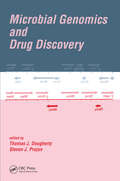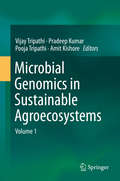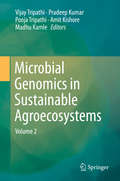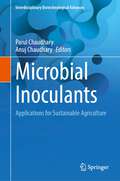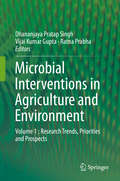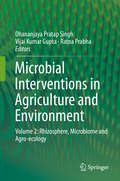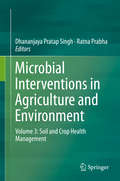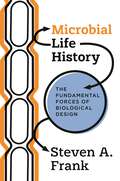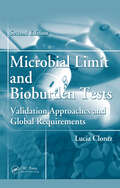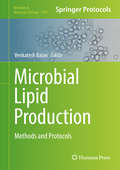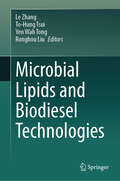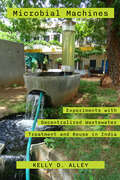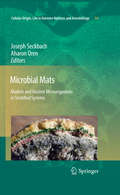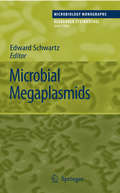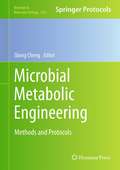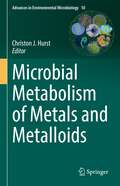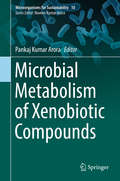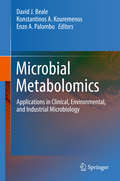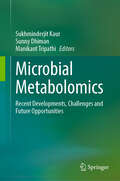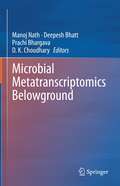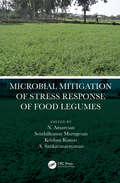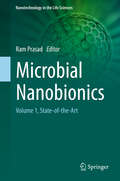- Table View
- List View
Microbial Genomics and Drug Discovery
by Thomas J. Dougherty Steven J. ProjanExploring innovative routes of drug discovery in the postgenomic era, Microbial Genomics and Drug Discovery examines bioinformatic and genomic approaches for the identification, detection, selection, and validation of new antibacterial targets and vaccine candidates. The book discusses potential pathways for effective infection control, inhibition of antibacterial resistance, and acceleration of the drug discovery process. This comprehensive reference describes procedures to recognize common targets in various bacterial species for the design of broad-spectrum antibiotics and clearly illustrates the use of pathway tools in a genomics-based drug discovery project.
Microbial Genomics in Sustainable Agroecosystems: Volume 1
by Pradeep Kumar Vijay Tripathi Pooja Tripathi Amit KishoreIn recent decades, significant advances in new methodologies like DNA sequencing and high-throughput sequencing have been used to identify microorganisms and monitor their interactions with different environments. Microbial genomics techniques are opening new approaches to microbiology by revealing how microorganisms affect human beings and the environment. This book covers four major areas: 1) Environmental microbial genomics, 2) Microbial genomics in human health, 3) Microbial genomics in crop improvement and plant health protection, and 4) Genome analysis of microbial pathogens. Within these areas, the topics addressed include: microbial genome diversity, evolution, and microbial genome sequencing; bioinformatics and microarray-based genomic technologies; functional genomics of bioremediation of soil and water from organic and inorganic pollutants and carbon management; functional genomics of microbial pathogens and relevant microorganisms; functional genomics of model microorganisms; and applied functional genomics. Given its scope, the book offers a comprehensive source of information on the latest applications of microorganisms and microbial genomics to enhance the sustainability of agriculture and the environment.
Microbial Genomics in Sustainable Agroecosystems: Volume 2
by Pradeep Kumar Madhu Kamle Vijay Tripathi Pooja Tripathi Amit KishoreToday, microbiology is a rapidly growing discipline in the life sciences, and the technologies are evolving on a virtually daily basis. Next-generation sequencing technologies have revolutionized microbial analysis, and can help us understand the biology and genomic diversity of various bacterial species with significant impacts on agro-ecosystems. In addition, advances in molecular biology and microbiology techniques hold the potential to improve the productivity and sustainability of agriculture and forestry.This new volume addresses the role of microbial genomics in understanding the living systems that exist in the soil and their interactions with plants, an aspect that is also important for crop improvement. The topics covered focus on a deeper and clearer understanding of how microbes cause diseases, the genome-based development of novel antibacterial agents and vaccines, and the role of microbial genomics in crop improvement and agroforestry. Given its scope, the book offers a valuable resource for researchers and students of agriculture and infectious biology.
Microbial Inoculants: Applications for Sustainable Agriculture (Interdisciplinary Biotechnological Advances)
by Parul Chaudhary Anuj ChaudharyThis book discusses the role of microbes in agriculture for plant attributes, soil fertility, and bio-remediation, which aid in sustainable agriculture. Nowadays, due to increase in human population, it is essential to increase food productivity in the near future, but exhaustive non-sustainable agricultural practices such as the usage of agrochemicals threaten food security, the economy, and the environment globally. Soil deterioration is the most serious environmental threat to food production, resulting in poverty and hunger in developing countries. As a result, the global community has faced challenges regarding the development of ecologically sound, efficient, and long-term alternative options to meet rising food requirements. Therefore, to contribute to food security, the advancement of sustainable and innovative modern agriculture aimed at addressing environmental, economic, and social challenges connected with present intense non-sustainable agriculture practices is required. As a result, beneficial microbial inoculants will be widely used in the development of new strategies to increase sustainable food production. Bioinoculant application helps to provide nutrients that directly support soil health and sustainable food production. Hence, this book offers the role of microbial inoculants for better agronomical performance for sustainable advancement in agriculture and also pays attention to soil health improvement for extensive period benefits. The book will be highly recommended for agriculture microbiologists, agronomists, plant pathologists, and related areas.
Microbial Interventions in Agriculture and Environment: Volume 1 : Research Trends, Priorities and Prospects
by Vijai Kumar Gupta Dhananjaya Pratap Singh Ratna PrabhaMicrobial communities and their functions play a crucial role in the management of ecological, environmental and agricultural health on the Earth. Microorganisms are the key identified players for plant growth promotion, plant immunization, disease suppression, induced resistance and tolerance against stresses as the indicative parameters of improved crop productivity and sustainable soil health. Beneficial belowground microbial interactions with the rhizosphere help plants mitigate drought and salinity stresses and alleviate water stresses under the unfavorable environmental conditions in the native soils. Microorganisms that are inhabitants of such environmental conditions have potential solutions for them. There are potential microbial communities that can degrade xenobiotic compounds, pesticides and toxic industrial chemicals and help remediate even heavy metals, and thus they find enormous applications in environmental remediation. Microbes have developed intrinsic metabolic capabilities with specific metabolic networks while inhabiting under specific conditions for many generations and, so play a crucial role. The book Microbial Interventions in Agriculture and Environment is an effort to compile and present a great volume of authentic, high-quality, socially-viable, practical and implementable research and technological work on microbial implications. The whole content of the volume covers protocols, methodologies, applications, interactions, role and impact of research and development aspects on microbial interventions and technological outcomes in prospects of agricultural and environmental domain including crop production, plan-soil health management, food & nutrition, nutrient recycling, land reclamation, clean water systems and agro-waste management, biodegradation & bioremediation, biomass to bioenergy, sanitation and rural livelihood security. The covered topics and sub-topics of the microbial domain have high implications for the targeted and wide readership of researchers, students, faculty and scientists working on these areas along with the agri-activists, policymakers, environmentalists, advisors etc. in the Government, industries and non-government level for reference and knowledge generation.
Microbial Interventions in Agriculture and Environment: Volume 2: Rhizosphere, Microbiome and Agro-ecology
by Vijai Kumar Gupta Dhananjaya Pratap Singh Ratna PrabhaMicrobial communities and their functions play a crucial role in the management of ecological, environmental and agricultural health on the Earth. Microorganisms are the key identified players for plant growth promotion, plant immunization, disease suppression, induced resistance and tolerance against stresses as the indicative parameters of improved crop productivity and sustainable soil health. Beneficial belowground microbial interactions with the rhizosphere help plants mitigate drought and salinity stresses and alleviate water stresses under the unfavorable environmental conditions in the native soils. Microorganisms that are inhabitants of such environmental conditions have potential solutions for them. There are potential microbial communities that can degrade xenobiotic compounds, pesticides and toxic industrial chemicals and help remediate even heavy metals, and thus they find enormous applications in environmental remediation. Microbes have developed intrinsic metabolic capabilities with specific metabolic networks while inhabiting under specific conditions for many generations and, so play a crucial role. The book Microbial Interventions in Agriculture and Environment is an effort to compile and present a great volume of authentic, high-quality, socially-viable, practical and implementable research and technological work on microbial implications. The whole content of the volume covers protocols, methodologies, applications, interactions, role and impact of research and development aspects on microbial interventions and technological outcomes in prospects of agricultural and environmental domain including crop production, plan-soil health management, food & nutrition, nutrient recycling, land reclamation, clean water systems and agro-waste management, biodegradation & bioremediation, biomass to bioenergy, sanitation and rural livelihood security. The covered topics and sub-topics of the microbial domain have high implications for the targeted and wide readership of researchers, students, faculty and scientists working on these areas along with the agri-activists, policymakers, environmentalists, advisors etc. in the Government, industries and non-government level for reference and knowledge generation.
Microbial Interventions in Agriculture and Environment: Volume 3: Soil and Crop Health Management
by Dhananjaya Pratap Singh Ratna PrabhaMicrobial communities and their multi-functionalities play a crucial role in the management of soil and plant health, and thus help in managing agro-ecology, the environment and agriculture. Microorganisms are key players in N-fixation, nutrient acquisition, carbon sequestration, plant growth promotion, pathogen suppression, induced systemic resistance and tolerance against stresses, and these parameters are used as indicators of improved crop productivity and sustainable soil health. Beneficial belowground microbial interactions in the rhizosphere help plants combat abiotic challenges in the unfavourable environmental conditions of native soils. These microorganisms and their products offer potential solutions for agriculture in problematic areas since they are able to degrade xenobiotic compounds, pesticides and toxic chemicals and help remediate heavy metals in the rhizosphere and so make deteriorated soils suitable for crop production. This book compiles the latest research on the role of microbes in the rhizosphere and agro-ecology, covering interaction mechanisms, microbe-mediated crop production, plant and soil health management, food and nutrition, nutrient recycling, land reclamation, clean water systems, agro-waste management, biodegradation, bioremediation, biomass and bioenergy, sanitation and rural livelihood security. It is a comprehensive reference resource for agricultural activists, policymakers, environmentalists and advisors working for governments, non-governmental organizations and industries, helping them update their knowledge of this important, but often neglected, research area.
Microbial Life History: The Fundamental Forces of Biological Design
by Steven A. FrankA powerful framework for understanding how natural selection shapes adaptation and biological designDesign and diversity are the two great challenges in the study of life. Microbial Life History draws on the latest advances in microbiology to describe the fundamental forces of biological design and apply these evolutionary processes to a broad diversity of traits in microbial metabolism and biochemistry.Emphasizing how to formulate and test hypotheses of adaptation, Steven Frank provides a new foundation for exploring the evolutionary forces of design. He discusses the economic principles of marginal valuations, trade-offs, and payoffs in risky and random environments; the social aspects of conflict and cooperation; the demographic aspects of age and spatial heterogeneity; and the engineering control theory principles by which systems adjust to environments. Frank then applies these evolutionary principles to the biochemistry of microbial metabolism, providing the first comprehensive link between the forces that shape biological design and cellular energetics.Tracing how natural selection sculpts metabolism, Microbial Life History provides new perspectives on the life histories of organisms, from growth rate and survival to dispersal and defense against attack. Along the way, this incisive book addresses the conceptual and philosophical challenges confronting evolutionary biologists and other practitioners who study biological design and seek to apply its lessons.
Microbial Limit and Bioburden Tests: Validation Approaches and Global Requirements,Second Edition
by Lucia ClontzIn recent years, the field of pharmaceutical microbiology has experienced numerous technological advances, accompanied by the publication of new and harmonized compendial methods. It is therefore imperative for those who are responsible for monitoring the microbial quality of pharmaceutical/biopharmaceutical products to keep abreast of the latest c
Microbial Lipid Production: Methods and Protocols (Methods in Molecular Biology #1995)
by Venkatesh BalanThe volume explores methods for isolation and characterization of lipids, and their production using various oleaginous organisms. The protocols presented in the book consider sugars derived from different substrates including chemically pre-treated agricultural residues, industrial residues containing lignin, food wastes, and industrial waste water in an approachable format. The book also discusses applications that use oleaginous organisms to transform substrates into a variety of products including bio-crude, high value fatty acids, biofuels such as biodiesel, neutral lipids, volatile fatty acids, and surfactants. Written in the highly successful Methods in Molecular Biology series format, chapters include introductions to their respective topics, lists of the necessary materials and reagents, step-by-step, readily reproducible laboratory protocols, and tips on troubleshooting and avoiding known pitfalls.Comprehensive and cutting-edge, Microbial Lipid Production: Methods and Protocols is a valuable resource aimed at novice researchers who are working on improving their knowledge and skills in this developing field.
Microbial Lipids and Biodiesel Technologies
by Le Zhang To-Hung Tsui Yen Wah Tong Ronghou LiuThis book, belonging to energy discipline, summarized the latest research progress in the development of microbial lipids and biodiesel technologies. This book introduced the concept and development of microbial lipids and biodiesel technologies, the microbial lipid technology based on oleaginous yeasts, filamentous fungi, microalgae, bacteria, and thraustochytrids. Meanwhile, this book introduced the inhibition and removal of lignocellulosic hydrolysis inhibitors on microbial fermentation for lipid production, the isolation and screening of high-yield strains of oleaginous microorganisms, the use of metabolic engineering to transform oleaginous microorganisms, the process engineering technologies for optimization and process improvement, the harvesting of microbial cells and the extraction of microbial lipids, the production of crude biodiesel by esterification of microbial lipids, the biodiesel purification technology as well as the challenges and prospects of the industrialization of biodiesel technology based on microbial lipids. Reading this book will help readers comprehensively understand the latest developments in the field of "microbial lipids and biodiesel technologies". This book takes into account the relevant practical engineering technologies and the latest basic scientific research, and can be used as a reference for the researchers, engineers, investors, policy-makers, and students engaged in clean energy, microbial lipids and biodiesel industries.
Microbial Machines: Experiments with Decentralized Wastewater Treatment and Reuse in India
by Kelly D. AlleyAround 2004, members of governmental and nongovernmental organizations, science institutes, and private companies throughout India began brainstorming and then experimenting with small-scale treatment systems that could produce usable water from wastewater. Through detailed case studies, Microbial Machines describes how residents, workers, and scientists interact with technology, science, and engineering during the processes of treatment and reuse. Using a human-machine-microbe framework, Kelly Alley explores the ways that people's sensory perceptions of water—including disgust—are dynamic and how people use machines and microbes to digest wastewater. A better understanding of how the human and nonhuman interact in these processes will enable people to generate more effective methods for treating and reusing wastewater. While decentralized wastewater treatment systems may not be a perfect solution, they alleviate resource stress in regions that are particularly hard hit by climate change. These case studies have broad relevance for solving similar problems in many other places around the world.
Microbial Mats
by Joseph Seckbach Aharon OrenThis book provides information about microbial mats, from early fossils to modern mats located in marine and terrestrial environments. Microbial mats - layered biofilms containing different types of cells - are most complex systems in which representatives of various groups of organisms are found together. Among them are cyanobacteria and eukaryotic phototrophs, aerobic heterotrophic and chemoautotrophic bacteria, protozoa, anoxygenic photosynthetic bacteria, and other types of microorganisms. These mats are perfect models for biogeochemical processes, such as the cycles of chemical elements, in which a variety of microorganisms cooperate and interact in complex ways. They are often found under extreme conditions and their study contributes to our understanding of extremophilic life. Moreover, microbial mats are models for Precambrian stromatolites; the study of modern microbial mats may provide information on the processes that may have occurred on Earth when prokaryotic life began to spread.
Microbial Megaplasmids
by Edward SchwartzMegaplasmids are extrachromosomal genetic elements in the size range of 100 kb and larger. They are found in physiologically and phylogenetically diverse groups of bacteria and archaea. By definition, megaplasmids are not essential for the viability of their hosts under all growth conditions, but paradoxically many megaplasmids carry the genetic information for the defining and characteristic traits of the organism in which they reside. Microbial Megaplasmids reviews our knowledge of the extensively studied representatives, such as the catabolic plasmids of the pseudomonads, the rhizobial Sym plasmids, the Ti plasmids of the genus Agrobacterium and the giant enterobacterial virulence plasmids. It also presents snapshots of more recently discovered megaplasmids. The contribution of megaplasmids to the biology of their hosts is described, highlighting the interactions between megaplasmid and chromosomal genes.
Microbial Metabolic Engineering
by Qiong ChengMetabolic engineering is the practice of genetically optimizing metabolic and regulatory networks within cells to increase production and/or recovery of certain substance from cells. In Microbial Metabolic Engineering: Methods and Protocols expert researchers in the field detail many of the methods which are now commonly used to study metabolic engineering. These include methods and techniques to engineer genes and pathways, use of modern biotechnology tools in microbial metabolic engineering, and examples of metabolic engineering for real world applications such as whole cell biosensors and acetate control in large scale fermentation. Written in the highly successful Methods in Molecular BiologyTM series format, chapters include introductions to their respective topics, lists of the necessary materials and reagents, step-by-step, readily reproducible laboratory protocols, and key tips on troubleshooting and avoiding known pitfalls. Authoritative and practical, Microbial Metabolic Engineering: Methods and Protocols seeks to provide researchers with an overview of key topics on microbial metabolic engineering.
Microbial Metabolism In The Digestive Tract
by M. J. HillIn this book an attempt has been made to give an update on the flora of the human digestive tract and its role in disease. This is a subject that has implications in many disciplines and therefore is aimed at not only microbiologists, but also clinicians, dentists, medical researchers, biochemists, and toxicologists who have a background knowledge of bacteriology but are not necessarily directly involved in research into the metabolic actions of gut bacteria.
Microbial Metabolism of Metals and Metalloids (Advances in Environmental Microbiology #10)
by Christon J. HurstThis book explains the metabolic processes by which microbes obtain and control the intracellular availability of their required metal and metalloid ions. The book also describes how intracellular concentrations of unwanted metal and metalloid ions successfully are limited. Its authors additionally provide information about the ways that microbes derive metabolic energy by changing the charge states of metal and metalloid ions.Part one of this book provides an introduction to microbes, metals and metalloids. It also helps our readers to understand the chemical constraints for transition metal cation allocation.Part two explains the basic processes which microbes use for metal transport. That section also explains the uses, as well as the challenges, associated with metal-based antimicrobials.Part three gives our readers an understanding that because of microbial capabilities to process metals and metalloids, the microbes have become our best tools for accomplishing many jobs. Their applications in chemical technology include the design of microbial consortia for use in bioleaching processes that recover metal and metalloid ions from industrial wastes. Many biological engineering tasks, including the synthesis of metal nanoparticles and similar metalloid structures, also are ideally suited for the microbes. Part four describes unique attributes associated with the microbiology of these elements, progressing through the alphabet from antimony and arsenic to zinc.
Microbial Metabolism of Xenobiotic Compounds (Microorganisms for Sustainability #10)
by Pankaj Kumar AroraXenobiotic compounds including pesticides, nitrophenols, pyridine, polycyclic aromatic compounds and polychlorinated biphenyls are widely spread in environment due to anthropogenic activities. Most of them are highly toxic to living beings due to their mutagenic and carcinogenic properties. Therefore, the removal of these compounds from environment is an essential step for environmental sustainability. Microbial remediation has emerged as an effective technology for degradation of these xenobiotic compounds as microorganisms have unique ability to utilize these compounds as their sole source of carbon and energy. The primary goal of this book is to provide detailed information of microbial degradation of many xenobiotic compounds in various microorganisms.
Microbial Metabolomics
by David J. Beale Konstantinos A. Kouremenos Enzo A. PalomboThis book brings together contributions from global experts who have helped to facilitate the exciting and rapid advances that are taking place in microbial metabolomics. The main application of this field is in clinical and veterinary microbiology, but there is a great potential to apply metabolomics to help to better understand complex biological systems that are dominated by multiple-species microbial populations exposed to changing growth and nutritional conditions. In particular, environmental (e. g. , water, soil), food (e. g. , microbial spoilage, food pathogens), and agricultural and industrial applications are seen as developing areas for microbial metabolomics. As such, the book includes contributions with clinical, environmental, and industrial perspectives.
Microbial Metabolomics: Methods and Protocols (Methods in Molecular Biology #1859)
by Edward E.K. BaidooThis detailed volume includes protocols that represent the breadth of microbial metabolomics approaches to both large-scale and small-scale experiments with intention of highlighting techniques that can be used for applications ranging from environmental microbiology to human disease. Utilizing mass spectrometry as their primary measurement tool, the chapters explore microbial metabolomics, metabolism and microbial physiology, metabolite sample preparation, current analytical techniques used to profile primary and secondary metabolites and lipids, as well as establishing data analysis workflows for targeted metabolomics, untargeted metabolomics, analysis of metabolic fluxes, and genome-scale models. Written for the highly successful Methods in Molecular Biology series, chapters include introduction to their respective topics, lists of the necessary materials and reagents, step-by-step readily reproducible protocols, and tips on troubleshooting and avoiding known pitfalls.Authoritative and practical, Microbial Metabolomics: Methods and Protocols serves as an ideal reference for both novice and advanced users and can be adapted to similar analytical platforms or customized to suit the needs of the researcher.
Microbial Metabolomics: Recent Developments, Challenges and Future Opportunities
by Sunny Dhiman Sukhminderjit Kaur Manikant TripathiThis book explores the potential of microbial metabolism in health, agriculture, and environmental technologies, serving as a comprehensive guide to microbial metabolomics with practical applications. It uncovers the complex biochemical processes of microbes, from bacteria to fungi, revealing their impact on biotechnology, environmental sciences, healthcare, and agriculture. Microbes, the unseen drivers of biological processes, offer innovative solutions across these fields. The book examines the rapid advancements in microbial metabolomics and addresses challenges like data integration and metabolite identification, providing insights to unlock its full potential. It caters to the growing demand for advanced resources in microbiology and biotechnology, making it valuable for researchers, students, and professionals in microbiology, biotechnology, and biochemistry, as well as innovators in food security and green technology.
Microbial Metal Respiration
by Andreas Kappler Johannes GescherMicrobes can respire on metals. This seemingly simple finding is one of the major discoveries that were made in the field of microbiology in the last few decades. The importance of this observation is evident. Metals are highly abundant on our planet. Iron is even the most abundant element on Earth and the forth most abundant element in the Earth's crust. Hence, in some environments iron, but also other metals or metalloids, are the dominant respiratory electron acceptors. Their reduction massively drives the carbon cycle in these environments and establishes redox cycles of the metallic electron acceptors themselves. These redox cycles are not only a driving force for other biotic reactions but are furthermore necessary for initiating a number of geochemically relevant abiotic redox conversions. Although widespread and ecologically influential, electron transfer onto metals like ferric iron or manganese is biochemically challenging. The challenge is to transfer respiratory electrons onto metals that occur in nature at neutral pH in the form of metal oxides or oxihydroxides that are effectively insoluble. Obviously, it is necessary that the microbes specially adapt in order to catalyze the electron transfer onto insoluble electron acceptors. The elucidation of these adaptations is an exciting ongoing process. To sum it up, dissimilatory metal reduction has wide-spread implications in the field of microbiology, biochemistry and geochemistry and its discovery was one of the major reasons to establish a novel scientific field called geomicrobiology. Recently, the discovery of potential applications of dissimilatory metal reducers in bioremediation or current production in a microbial fuel cell further increased the interest in studying microbial metal reduction
Microbial Metatranscriptomics Belowground
by Prachi Bhargava Manoj Nath Deepesh Bhatt D. K. ChoudharyThe book emphasizes role of functional microbes in soil to improve fertility and plant health in agro-ecosystem. In this compendium main emphasis is on occurrence and distribution of microbial communities, In situ active microbial quorum in rhizosphere, metratranscriptomics for microflora- and fauna, and fnctional diversity in rhizosphere. The book also highlights the importance of PGPRs in rhizosphere, root endotrophic microbes, functional niche under biotic stress, functional niche under abiotic stress, functional root derived signals, as well as functional microbe derived signals. Approaches deployed in metatranscriptomics, and molecular Tools used in rhizosphere are also discussed in detail. The book presents content is useful for students, academicians, researchers working on soil rhizosphere and as a policy document on sustenance of agriculture.
Microbial Mitigation of Stress Response of Food Legumes
by Krishna Kumar A. Sankaranarayanan N. Amaresan Senthilkumar MurugesanMicrobial Mitigation of Stress Responses of Food Legumes provides knowledge on the impact of abiotic and biotic stress on the agriculture of grain legumes especially pulses and it critically reviews the cutting-edge research in exploring plant microbe interactions to mitigate the stress. It helps in understanding the fundamentals of microbial-mediated management of abiotic and biotic stress in grain legumes. Salient features: Describes the usefulness of microbiome of plant/insects for enhancing the production of grain legumes Focuses on recent advances in microbial methods for mitigating the stress and their application in sustainability of legume production Provides a unique collection of microbial data for the improvement of legume productivity Details microbial metabolites at the gene and molecule levels for plant stress management The reader will get all essential and updated information on various stress factors, crop responses, and microbial-mediated stress management for better food legume production.
Microbial Nanobionics: Volume 1, State-of-the-Art (Nanotechnology in the Life Sciences)
by Ram PrasadMicrobial Nanobionics: Volume 1, State of the Art, discusses a wide range of microbial systems and their utilization in biogenic synthesis of metallic nanoparticles. The rich biodiversity of microbes makes them excellent candidates for potential nanoparticle synthesis biofactories. Through a better understanding of the biochemical and molecular mechanisms of the microbial biosynthesis of metal nanoparticles, the rate of synthesis can be better developed and the monodispersity of the product can be enhanced. The characteristics of nanoparticles can be controlled via optimization of important parameters, such as temperature, pH, concentration and pressure, which regulate microbe growth conditions and cellular and enzymatic activities. Large scale microbial synthesis of nanoparticles is a sustainable method due to the non-hazardous, non-toxic and economical nature of these processes.The applications of microbial synthesis of nanoparticles are wide and varied, spanning the industrial, biomedical and environmental fields. Biomedical applications include improved and more targeted antimicrobials, biosensing, imaging and drug delivery. In the environmental fields, nanoparticles are used for bioremediation of diverse contaminants, water treatment, catalysis and production of clean energy. With the expected growth of microbial nanotechnology, this volume will serve as a comprehensive and timely reference.
